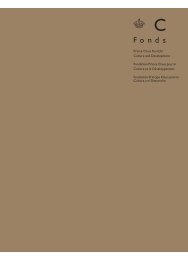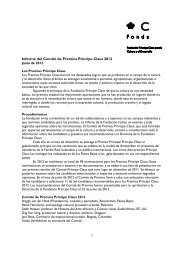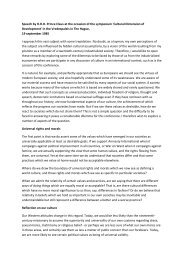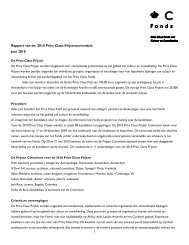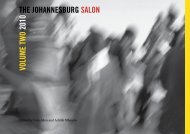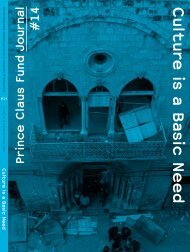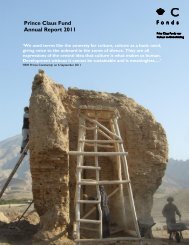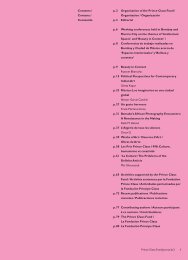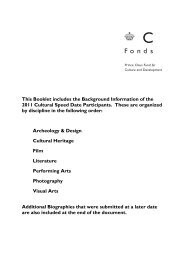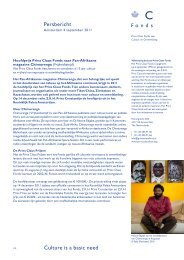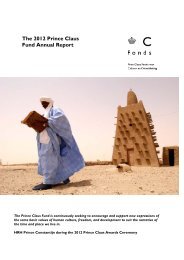3 summer 2011 - Prince Claus Fund
3 summer 2011 - Prince Claus Fund
3 summer 2011 - Prince Claus Fund
- No tags were found...
Create successful ePaper yourself
Turn your PDF publications into a flip-book with our unique Google optimized e-Paper software.
saima zaidi232PML-N, the lion is also a reference to the popular folklore of Jagga, a colonial-dayRobin Hood from Sialkot. Novelty was added to some of the PML-N’s campaign rallies by the presence of a live lion in a cage while othermore practical and animal-friendly versions were lion sculptures flankingthe podium, stuffed toy lions held aloft by party members or affixed to theroof of a car. One PML-N activist exhibited creative genius by stretching astriped animal-print skin over the hood of his car (Figure 13).The election symbols are thus open to interpretation by political parties,proving Gombrich’s notion of ‘the beholder’s share’. Meaning, thus,lies in the eyes of the beholder much like an ‘image in the clouds’ or theproverbial ink blot; you see what you want to see. For example, the kite(Figure 11) was the symbol of choice for the Muttahida Qaumi Movement(MQM), which started out as a party for Urdu-speaking Muslims (or Muhajirs)who migrated to Pakistan at Partition in 1947. The kite, generallyassociated with the attainment of height, could also refer to the notionof the kati patang or literally ‘the kite cut loose’ symbolising the ‘displacement’of the Muhajirs, as explained by a supporter. iNot all symbols, however, find resonance with political parties and voters;in fact, they may even have negative connotations. For example, the kursi(chair) implying a lust for power in popular Urdu idiom, was considered,by and large politically incorrect, while the lota, a vessel used for ablutionand disparagingly applied to political turncoats was soundly rejected inthe 2008 elections.Thus, the election symbol primarily serves as an identification device.Its relentless exposure ensures that it becomes ingrained in the voter’sconsciousness and is instantly recognised when it is time to stamp theballot paper.the prophets of politicsPolitics in Pakistan remains personality- (and not issue-) driven, theleader or the chairperson being the party’s most visible face. ‘The cult ofpersonality cannot be separated from the image or objectives of a party,’ 8and the visual campaigns for the elections 2008 were no different; smilingcandidates greeted the public from billboards, posters and banners(Figures 20–40). These faces carpeted the city and it is arguable that not asingle neighbourhood or major road was without them. What was conspicuouslyabsent from these graphic statements, however, was the image ofthe awam or masses, the people responsible for bringing them to power.Thus, the political poster for the 2008 elections aimed at doing littlemore than ‘stimulat[ing] (and simplify[ing]) moral sentiments’ as SusanSontag puts it, something that was ‘classically achieved through a visualmetaphor, usually a thing or an idea, being attached to the emblematicimage of a person’. This principle also plays out in commercial advertisingas exemplified by the pervasive use of the image of a pretty girl or asMarshall McLuhan puts it, the ‘mechanical bride’. ‘The equivalent ini. Revealed to Saquib Hanif (former editor of Herald magazine), by an MQM activist.Also to capitalize on their election symbol, a patang mela ‘kite-festival’ was heldat Nishtar Park as part of MQM’s pre-election campaign (recalling Basant, a kiteflyingfestival to welcome spring in the Punjab).Figures 14–19. Wall chalkings on Shahrah-e Faisalto welcome Benazir Bhutto’s arrival in Karachi,October 2007.Figures 14–17. This wall on the way to the airportreads ‘Challo challo’ (Let’s go, let’s go),a popular call to invite the public, especiallyto a political gathering. It continues, ‘Airportchallo, Mohtarma Benazir Bhutto ka tareekhiIstaqbal’ which means ‘Let’s go to the airportto give Benazir Bhutto a historic welcome’ on18 October 2007.Figure 18 declares ‘Benazir Ayegi, RozgarLayegi’ (Benazir will come, bringing gainfulemployment).Figure 19. ‘Fakhre Asia, Dukhtare Mashriq’(The Pride of Asia, Daughter of the East). Thepopularity of certain slogans can be gauged bytheir adoption by several parties for example,the poster for Zubeida Jalal, former EducationMinister celebrated her as ‘Daughter ofMakran, The Pride of Balochistan’ in Elections2002 in which she participated as an independentcandidate (not shown here).Figure 20. Thousands of photographs of thelate PPP chairperson have been used in everyconceivable graphics with her white dupattacovering her head. This poster shows Benazirprominently placed within a crescent with herface towards the Ka’aba and hands raised inprayer. This Reuters photograph showed herstopping while descending from the plane uponher arrival in Karachi on 18 October 2007after years of exile. She was captured frombelow as she lifted her hands in a prayer ofthanks for her return to Pakistan. This muchreproducedsemi-religious image came to carryintense meaning after her death.Figure 21. A banner of Benazir Bhutto beingunfurled for a gathering in Liaquat Bagh,Rawalpindi where she was assassinated. Itreads ‘Shaheed-i Jamhooriyat’ (Martyrfor Democracy) and ‘Ya Allah, Ya RasoolBenazir Beqasoor, Benazir Beqasoor, BenazirBeqasoor’ the slogan invoking God and theProphet (PBUH) and repeating the statement‘Benazir Innocent’.Figure 22. Poster by artist Khuda Bux Abro.As part of his political activism, Abro hasdesigned several posters which he uploads forviewing on the internet. This poster was inreaction to the 27 March 2008 meeting ofNational Assembly when slogans of ‘Zinda haiBhutto Zinda hai’ (Alive, Bhutto is Alive) wereraised defiantly in the oath-taking ceremony. Inthis poster the slogan is repeated several timesto visually capture the echoes.<strong>Prince</strong> <strong>Claus</strong> <strong>Fund</strong> Reader #1 · Summer <strong>2011</strong> · 22



